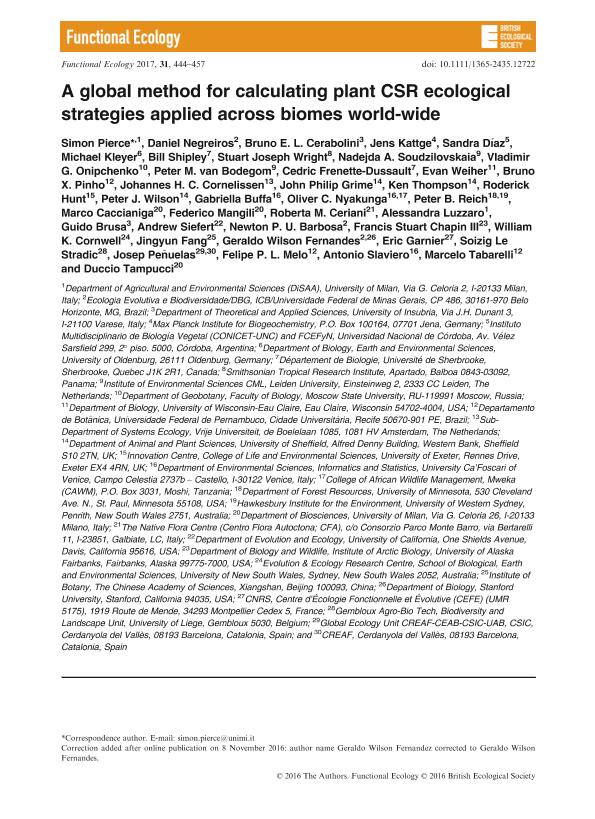Artículo
A global method for calculating plant CSR ecological strategies applied across biomes world-wide
Pierce, Simon; Negreiros, Daniel; Cerabolini, Bruno E. L.; Kattge, Jens; Díaz, Sandra Myrna ; Grime, John Philip; Thompson, Ken; Hunt, Roderick; Wilson, Peter J.; Buffa, Gabriella; Nyakunga, Oliver C.; Reich, Peter B.; Caccianiga, Marco; Mangili, Federico; Ceriani, Roberta M.; Luzzaro, Alessandra; Brusa, Guido; Siefert, Andrew; Barbosa, Newton P. U.; Chapin III, Francis Stuart; Cornwell, William K.; Fang, Jingyun; Fernandes, Geraldo Wilson; Garnier, Eric; Le Stradic, Soizig; Peñuelas, Josep; Melo, Felipe P. L.; Slaviero, Antonio; Tabarelli, Marcelo; Tampucci, Duccio
; Grime, John Philip; Thompson, Ken; Hunt, Roderick; Wilson, Peter J.; Buffa, Gabriella; Nyakunga, Oliver C.; Reich, Peter B.; Caccianiga, Marco; Mangili, Federico; Ceriani, Roberta M.; Luzzaro, Alessandra; Brusa, Guido; Siefert, Andrew; Barbosa, Newton P. U.; Chapin III, Francis Stuart; Cornwell, William K.; Fang, Jingyun; Fernandes, Geraldo Wilson; Garnier, Eric; Le Stradic, Soizig; Peñuelas, Josep; Melo, Felipe P. L.; Slaviero, Antonio; Tabarelli, Marcelo; Tampucci, Duccio
 ; Grime, John Philip; Thompson, Ken; Hunt, Roderick; Wilson, Peter J.; Buffa, Gabriella; Nyakunga, Oliver C.; Reich, Peter B.; Caccianiga, Marco; Mangili, Federico; Ceriani, Roberta M.; Luzzaro, Alessandra; Brusa, Guido; Siefert, Andrew; Barbosa, Newton P. U.; Chapin III, Francis Stuart; Cornwell, William K.; Fang, Jingyun; Fernandes, Geraldo Wilson; Garnier, Eric; Le Stradic, Soizig; Peñuelas, Josep; Melo, Felipe P. L.; Slaviero, Antonio; Tabarelli, Marcelo; Tampucci, Duccio
; Grime, John Philip; Thompson, Ken; Hunt, Roderick; Wilson, Peter J.; Buffa, Gabriella; Nyakunga, Oliver C.; Reich, Peter B.; Caccianiga, Marco; Mangili, Federico; Ceriani, Roberta M.; Luzzaro, Alessandra; Brusa, Guido; Siefert, Andrew; Barbosa, Newton P. U.; Chapin III, Francis Stuart; Cornwell, William K.; Fang, Jingyun; Fernandes, Geraldo Wilson; Garnier, Eric; Le Stradic, Soizig; Peñuelas, Josep; Melo, Felipe P. L.; Slaviero, Antonio; Tabarelli, Marcelo; Tampucci, Duccio
Fecha de publicación:
08/2016
Editorial:
Wiley Blackwell Publishing, Inc
Revista:
Functional Ecology
ISSN:
0269-8463
e-ISSN:
1365-2435
Idioma:
Inglés
Tipo de recurso:
Artículo publicado
Clasificación temática:
Resumen
Competitor, stress‐tolerator, ruderal (CSR) theory is a prominent plant functional strategy scheme previously applied to local floras. Globally, the wide geographic and phylogenetic coverage of available values of leaf area (LA), leaf dry matter content (LDMC) and specific leaf area (SLA) (representing, respectively, interspecific variation in plant size and conservative vs. acquisitive resource economics) promises the general application of CSR strategies across biomes, including the tropical forests hosting a large proportion of Earth´s diversity.We used trait variation for 3068 tracheophytes (representing 198 families, six continents and 14 biomes) to create a globally calibrated CSR strategy calculator tool and investigate strategy?environment relationships across biomes world‐wide.Due to disparity in trait availability globally, co‐inertia analysis was used to check correspondence between a ?wide geographic coverage, few traits? data set and a ?restricted coverage, many traits? subset of 371 species for which 14 whole‐plant, flowering, seed and leaf traits (including leaf nitrogen content) were available. CSR strategy/environment relationships within biomes were investigated using fourth‐corner and RLQ analyses to determine strategy/climate specializations.Strong, significant concordance (RV = 0·597; P < 0·0001) was evident between the 14 trait multivariate space and when only LA, LDMC and SLA were used.Biomes such as tropical moist broadleaf forests exhibited strategy convergence (i.e. clustered around a CS/CSR median; C:S:R = 43:42:15%), with CS‐selection associated with warm, stable situations (lesser temperature seasonality), with greater annual precipitation and potential evapotranspiration. Other biomes were characterized by strategy divergence: for example, deserts varied between xeromorphic perennials such as Larrea divaricata, classified as S‐selected (C:S:R = 1:99:0%) and broadly R‐selected annual herbs (e.g. Claytonia perfoliata; R/CR‐selected; C:S:R = 21:0:79%). Strategy convergence was evident for several growth habits (e.g. trees) but not others (forbs).The CSR strategies of vascular plants can now be compared quantitatively within and between biomes at the global scale. Through known linkages between underlying leaf traits and growth rates, herbivory and decomposition rates, this method and the strategy?environment relationships it elucidates will help to predict which kinds of species may assemble in response to changes in biogeochemical cycles, climate and land use.
Palabras clave:
Csr
,
Ecological Strategies
Archivos asociados
Licencia
Identificadores
Colecciones
Articulos(IMBIV)
Articulos de INST.MULTIDISCIPL.DE BIOLOGIA VEGETAL (P)
Articulos de INST.MULTIDISCIPL.DE BIOLOGIA VEGETAL (P)
Citación
Pierce, Simon; Negreiros, Daniel; Cerabolini, Bruno E. L.; Kattge, Jens; Díaz, Sandra Myrna; et al.; A global method for calculating plant CSR ecological strategies applied across biomes world-wide; Wiley Blackwell Publishing, Inc; Functional Ecology; 31; 8-2016; 444-457
Compartir
Altmétricas



